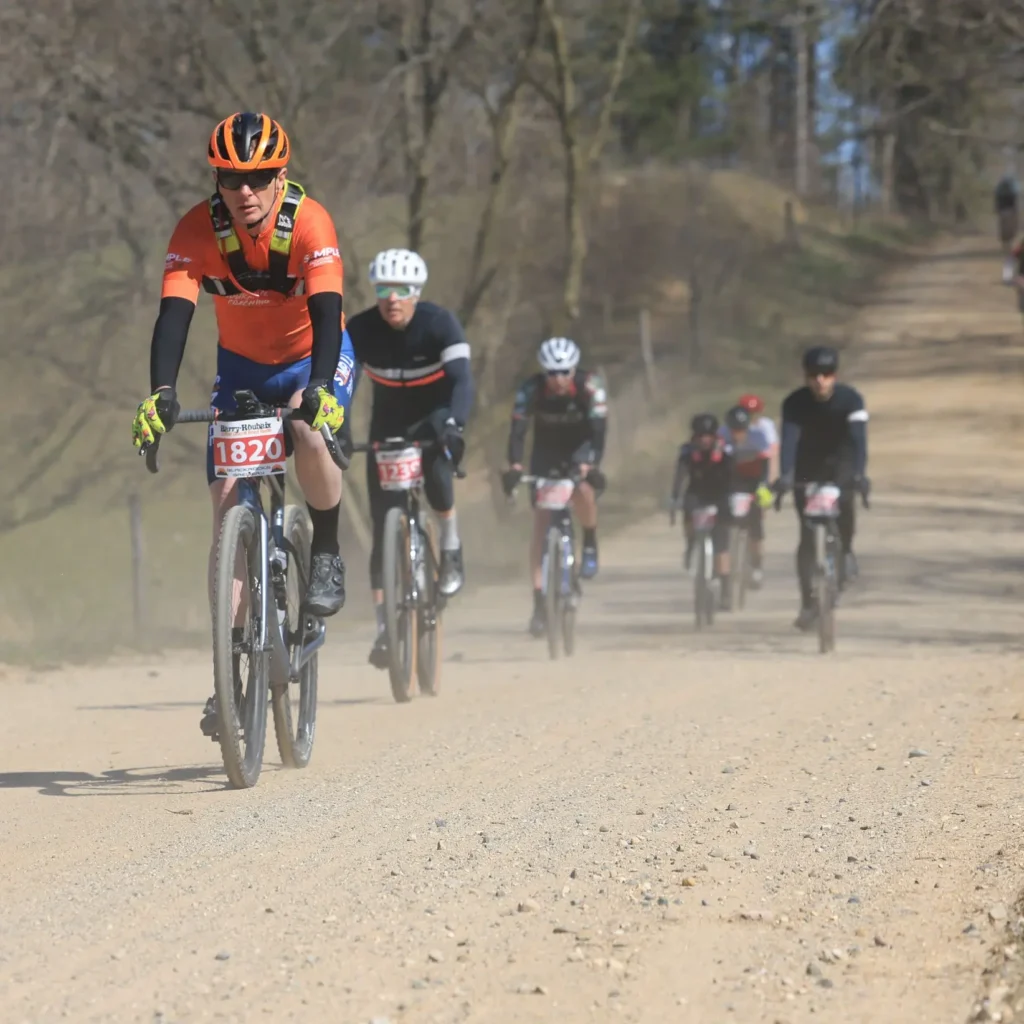Why is Periodization in Masters Cyclocross So Important in Your Training Plan
One of the biggest challenges in cyclocross racing is finding the right balance between peaking towards the end of the season and maintaining consistent performance throughout the entire series.
For example, in Wisconsin, we have 13 races, so you can try to win the series or you can peak for state championships at the end of the season.
Doing both requires periodization – careful planning and execution of the training plan.
To achieve a peak performance towards the end of the season, athletes typically employ a strategy known as “peaking.”
This involves gradually increasing the volume and intensity of training, followed by a tapering phase during which the workload decreases, allowing the body to recover and supercompensate.
Maybe you’ve been doing mountain bike, gravel, or road events this summer. Now you have to plan your cross season.
This strategic approach ensures that athletes are in top form when it matters most.
However, solely focusing on an end-of-season peak can come at the cost of overall performance throughout the year.
Athletes who neglect the importance of consistent training may struggle to maintain form during the early races or experience burnout before the crucial end-of-season events.

Why is cyclocross such a hard sport to improve fitness during the season?
Cyclocross is a unique sport that presents its own set of challenges when it comes to improving fitness during the season.
One of the main reasons for this is the demanding nature of cyclocross races themselves.
Unlike road cycling or mountain biking, where you can settle into a steady rhythm, cyclocross requires constant bursts of power as you navigate through technical terrain, steep climbs, and barriers.The intensity level in a cyclocross race is incredibly high from start to finish.
This means that your body needs to be prepared for repeated efforts at maximum output.
It’s not just about endurance – it’s about being able to sustain high power outputs while maintaining control and precision on challenging surfaces.Another factor that makes cyclocross training particularly challenging is the unpredictable weather conditions.
Cyclocross races often take place in muddy or slippery conditions, adding an extra layer of difficulty to each race.
This means that your training needs to include specific drills and exercises that mimic these conditions so that you can build the necessary skills and strength required to handle them effectively.Additionally, with a packed race calendar throughout the season, it can be tempting to focus solely on racing without allowing enough time for proper recovery and adaptation between events. Overtraining becomes a real risk if you don’t carefully plan your training schedule.
The combination of intense efforts, technical demands, unpredictable terrain and weather conditions make cyclocross a hard sport to improve fitness during the season.
However, by incorporating periodization into your training plan and addressing these specific challenges head-on, you can maximize your potential as a masters cyclist over 50 in this thrilling discipline!
Why is periodization in masters cyclocross important?
If you’re serious about improving your performance in cyclocross, then periodization is a key concept for your season.
Periodization refers to the strategic planning and organization of your training throughout the season.
This approach involves dividing your training into distinct phases or periods, each with specific goals and focuses.
Why is periodization important in cyclocross?
One reason is that it helps prevent overtraining and burnout.
Cyclocross is an intense and demanding sport, both physically and mentally.
Without good planning, it’s easy to fall into the trap of constantly pushing yourself too hard without allowing for adequate recovery time.
That doesn’t even take into account trying to improve your form during the season.So another benefit of periodization is that it allows for targeted improvement in different aspects of your fitness. During certain periods, you might focus on building strength or increasing endurance, while other times may prioritize speed or technical skills.
By structuring your training plan around these different phases, you give yourself the best chance at reaching peak performance when it matters most – during race season.
It also ensures that you are continuously challenging yourself without risking injury or stagnation.
What if I’m training to win the state championships?
If your goal is to win the state championships in masters cyclocross, then periodization becomes even more crucial in your training plan.
To be successful at this level of competition, you need to peak at the end of the season, maybe foregoing success in early season events.First and foremost, it’s important to understand that winning the state championships requires a long-term approach.
You can’t expect to achieve peak performance overnight.
This is where periodization comes into play.Periodization allows you to strategically divide your training into specific phases, each with its own focus and goals. By carefully planning when and how intensively you train, you can maximize your fitness gains leading up to the state championships.
In the early offseason phase, as I always say, you need to build a solid aerobic base through longer endurance rides. As you progress closer to race day, intensity increases with interval workouts focused on developing speed and power.
Another key aspect of training for state championships is incorporating race-specific skills and tactics into your workouts.
This includes practicing dismounts/remounts, cornering techniques, and handling obstacles like barriers or stairs – all essential elements of cyclocross racing.
As with any competitive endeavor, mental preparation is just as vital as physical training.
Visualizing success during races can help build confidence and improve performance under pressure.
Additionally, simulating race scenarios during training sessions can better prepare you for the challenges encountered during actual competition.Lastly but equally important is allowing ample recovery time between hard efforts or races. Remember that rest days are not wasted days; they are essential for proper muscle repair and adaptation.
By following a well-structured periodized training plan tailored specifically towards winning the state championships in masters cyclocross, you increase your chances of reaching peak form when it matters most.
What if I’m training to win the season-long series?
This is a whole different cross course.
Winning a single race is one thing, but winning an entire series requires consistent performance and strategic planning.To come out on top in the season-long series, you need to focus not only on your fitness level but also on pacing yourself throughout the entire season. It’s about finding a balance between pushing hard enough to stay competitive in each individual race while also allowing for recovery and avoiding burnout.
Periodization becomes even more crucial when aiming for success in a long-term competition like this.
You’ll want to structure your training plan so that you maintain a decent level of fitness all season long, with breaks to rebuild your fitness when you can.
This means carefully managing your training load, intensity, and recovery periods.
In addition to physical preparation, mental fortitude plays a significant role in winning a season-long series.
Staying motivated and focused over an extended period can be challenging, especially when faced with setbacks or disappointing results.
Developing strategies to cope with these challenges will help keep you on track towards achieving your goals.
Don’t forget about other factors that can impact your overall performance throughout the series.
Factors such as nutrition, strength training, yoga, bike maintenance, equipment selection, and race tactics all play their part in determining success.
What is the research behind periodization in cycling
Research has shown that periodization is highly effective in improving athletic performance in various sports, including cycling.
By progressively overloading the body and then allowing for adequate recovery, periodization prevents stagnation and promotes continuous improvement.
You push, then recover.
It helps athletes adapt to the increasing demands of the sport and avoid overtraining.Studies have shown that structured training plans with varying intensity and volume lead to greater gains in fitness compared to constant training loads. By strategically manipulating these variables throughout the season, athletes can optimize their progress while minimizing the risk of burnout or injury.
Additionally, research has found that periodized training can enhance physiological markers such as VO2 max, lactate threshold, and power output.
These improvements translate directly into better performance on race day.
By targeting specific energy systems during different phases of training – such as focusing on aerobic conditioning early on and then gradually introducing higher-intensity efforts – cyclists can develop well-rounded fitness necessary for cyclocross racing.It’s important to note that no single approach works for everyone when it comes to periodization in masters cyclocross. Each athlete has unique strengths, weaknesses, and goals that need to be considered when designing a personalized training plan.
Therefore, it’s always recommended to work with an experienced coach who understands both the demands of cyclocross racing and the principles of effective periodization.
Also remember the importance of rest, recovery, and listening to your body.
5 key principles for periodization in masters cyclocross seasons
When designing training plans for masters cyclists over 50, you have to remember skills, recovery, endurance, and speed.
Here are some key principles to keep in mind:
- Emphasize Recovery: As we age, recovery becomes increasingly important. Be mindful of incorporating adequate rest and active recovery days into your training plan. This will help prevent overuse injuries and allow your body to adapt to the demands of training.
- Prioritize Strength Training: With age, maintaining muscle mass and strength becomes essential. Include regular strength training sessions to improve overall power output and prevent age-related muscle loss. Focus on exercises that target specific muscle groups used in cyclocross, such as the legs, core, and upper body.
- Build Endurance: Masters cyclists often benefit from longer, sustained efforts to build endurance. Incorporate longer training rides to improve cardiovascular fitness and stamina. Endurance rides should be performed at a moderate intensity to avoid excessive fatigue.
- Work on Technical Skills: Cyclocross requires solid technical skills, particularly in navigating challenging terrain, dismounting, remounting, and shouldering the bike. Dedicate specific training sessions to honing these skills, focusing on technique rather than intensity.
- Include Periods of Intensity: To improve speed and power, incorporate intervals and high-intensity workouts into your training plan. These efforts should be challenging but tailored to your individual fitness level and recovery capacity.
Three things to know about periodizing your cyclocross season
- Decide whether you want to be good all season or you want to peak for end-of-the-season championships. It’s tough to do both.
- Carefully plan your mid-week workouts to sharpen your skills and speed.
- Take every opportunity to do long endurance rides to rebuild your fitness.
Need more?
Sign up for Virtual Coffee so we can discuss your goals, ask questions, and talk about making your endurance training more effective, fun, and Simple.
Get a free Core Strength and Stability training video when you opt-in to receive my weekly blog posts about what works in endurance sports.
Paul Warloski is a:
USA Cycling Level 3 CoachRRCA Running Coach
Training Peaks Level 2 Coach
RYT-200 Yoga Instructor
Certified Personal Trainer





